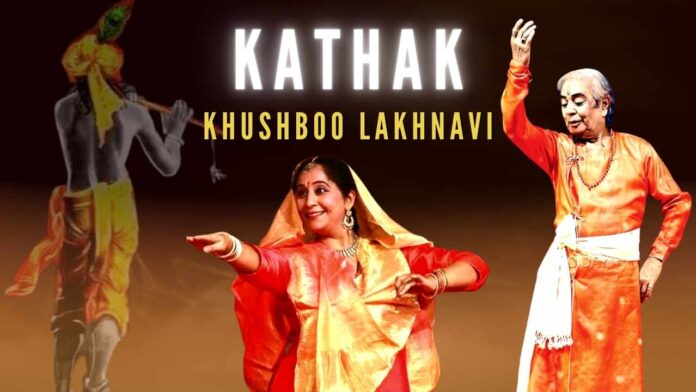
Kathak, a storytelling dance, a classical art form of India
Kathak means “Katha Kahe So Kathak Kehelave“, the one who tells a story is Kathak. Kathak is a classical dance form from northern India, mainly in Uttar Pradesh and Rajasthan. The wandering ‘kathakar’ communicated stories from great epics and puranas through dance, song, music, and enactment. Kathak evolved during the ‘Bhakti movement’, particularly by incorporating the childhood stories of the Hindu God Shri Krishna in the Mandir dedicated to him in Vrindavan and Braj.
Later the Kathakaars who stayed in Varanasi spread their wings in Jaipur, Lucknow, and other regions of North and Northwest India.
The Lucknow Gharana of Kathak was founded by Ishwari Prasad ji, a devotee of the Bhakti movement. Ishwari ji lived in the village of Handiya situated in southeast Uttar Pradesh. It is believed that Bhagwan Shri Krishna came in the dreams of Ishwari Prasad ji and taught him the dance which included the syllables ‘Tat- Tat, Kran, Tram, Tigda, etc., and instructed him to develop kathakars to “dance as a form of worship”. He taught the dance form to his sons Adguji, Kadguji, and Tularamji who again taught it to their descendants and the tradition continued for more than 6 generations. Thus carrying forward the legacy that is well acknowledged as the Lucknow Gharana of Kathak.
Mughal era
The ancient classical dance form that was majorly associated with Hindu epics was well-acknowledged by the Mughal Nawabs. The last Nawab of Awadh, Wajid Ali Shah was a great connoisseur of Kathak and classical music. He patronized Lucknow Gharana descendants Thakur Prasad ji, Bindadin Maharaj ji, Kalka Prasad ji, and some musicians, and the dance form evolved from Bhakti to entertainment. Kalka Bindadin Jodi was the most famous Jodi in Mughal courts. As the dance form was performed for the Nawabs it was developed in a graceful, erotic form without having much reference to particular themes applied earlier and the communicated religious or spiritual concepts. The dancers made improvisations predominantly to entertain the Muslim audience. As per the demand of the nawabs 5000 songs which include Hori, Geet, etc. were specially written by Bindadin Maharaj ji, but being from the Bhakti movement the songs or the poetry were written on the beautiful relation of Radhe-Krishna.
The improvisation of thumri was the most demanded by the Nawabs, it is said that Shambhu Maharaj ji used to perform and improvise one line of Thumri with different ‘bhava’ the entire night.
Colonial period
Later during the Colonial rule in the 18th and 19th centuries, the Kathak dance style saw a decline and discouragement. Eventually, the Christian missionaries launched the ‘Anti-Dance Movement’ in 1892 to stop such practice.
Revival
In the early 20th century, the Indian freedom movement saw an effort among Indians to revise National culture and tradition.
Kalka-Bindadin Jodi played an important role in drawing the International viewership of Kathak in the early 20th century.
The legendary Padma Vibhushan Pandit Birju Maharajji is considered the leading advocate of the seven generations of Lucknow Kalka-Bindadin Gharana. He was a torchbearer of this style. Besides being a super dancer, Maharajji was also gifted with a number of other qualities that added to his artistic career, he was a wonderful singer, a super drummer, a poet, a composer, and a painter.
In the solo dance recital, he introduced ‘Vandana’ which every dancer now after their entry on the stage starts with the invocation of God.
He took this dance form at the peak.
He gave a new dimension to Kathak, by experimenting with this technique in the application of dance dramas, which today became a very successful medium for mass productions.
Maharaj ji has done dance direction in Bollywood films like Devdas, Bajirao Mastani, Dil To Pagal Hai, Gadar, and many more. He has done amazing choreographies, to name a few,” Court”, “Editing” and also Shakespeare drama in Kathak “Romeo Juliet”.
Maharaj Ji’s descendants, his two sons, daughter, and his grandchildren are also taking this art form ahead.
I hope this liveliness, essence, and pure form of Kathak stays for a long and goes on from generation to generation……
Note:
1. Text in Blue points to additional data on the topic.
2. The views expressed here are those of the author and do not necessarily represent or reflect the views of PGurus.
PGurus is now on Telegram. Click here to join our channel and stay updated with all the latest news and views
For all the latest updates, download PGurus App.
- Kathak – Khushboo Lakhnavi - April 29, 2023








[…] Source link […]